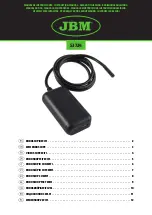
Type BM24L10 EHEDG Load Cell
Specifications and dimensions are subject to change without notice and do not constitute any liability whatsoever.
Zemic Europe B.V.
T: +31 76 50 39480
Nr. 2023.11 BM24L10 Installation and Operating Manual Rev1
Page 4/7
3 Cleaning
3.1 Cleaning Method
This sensor is a hygienic sensor, suitable for food, medical, biological and other application fields,
following the EHEDG design principles, including the absence of horizontal ledges, for draining.
The sensor is structurally easy to clean, and the result should be the same, no matter what cleaning
method the customer uses, such as dry cleaning and wet cleaning.
The sensor is suitable for wet cleaning without dismantling, so during cleaning, the sensor must not
be dismantled.
Recommended cleaning methods are as follows:
1) Dry cleaning, using tools including rag and/or a soft brush.
2) Wet cleaning, using wet cloth, chemicals, low pressure clean water.
3.2 Pre-Cautions
The operator should pay attention to the following matters in the cleaning process:
1) Cleaning carefully to prevent scratches on the outer surface of the sensor caused by cleaning
tools.
2) Regular cleaning to prevent dirt and micro-organisms from gathering and breeding.
3) Carefully clean, and the cleaning scope should include all leakage surfaces of the sensor.
4) When using chemicals for wet cleaning, the pH value of the chemical solution shall be between
5
and
9
, and hydrofluoric acid shall NOT be used for cleaning.
5)
High pressure
cleaning is prohibited! When using low pressure clean water for wet cleaning, the
water pressure shall not exceed
0.3Mpa (3 bar)
.
Figure 3-1 is the schematic diagram of using low pressure clean water for cleaning:
Figure 3-1 Cleaning by pressure clean water
Water hose



























